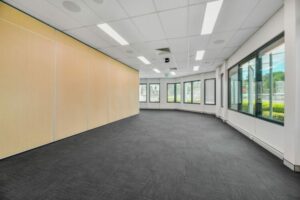
It pays to educate yourself on the latest techniques and product selections, even if the only thing you are attempting is reconstructing your old, leaking shower in exactly the same location with improved waterproofing and new finishes.
What Is the Ideal Shower Size?
Determine the footprint. Taking over a tub alcove, which is usually 3 by 5 feet, is an economical and space-efficient way to create a nice-sized bath. A mere three-feet square may be quite functional. Thinking of performing a bath remodel and getting a two-person bath? You might be able to install a shower head at either end if it is no less than 60 inches long.
Find the Location of Your Drain
If you’re rebuilding in the same manner without altering the size or form of the bath, leaving the drain in its current location will save you money. Additionally, a prefabricated bath pan that is pre-sloped downward in the drain and constructed of rigid polyurethane that is ready for tile can save both money and time if the location is conventional in size and shape. These pans also look beautiful and operate well.
Make additional provisions. Together with your contractor, go over the plumbing layout and ensure that the showerhead, shower valve, and anybody sprays are all at an appropriate level and comply with the water-usage code in your area.
A seat, if room permits, and a grasp bar or two—useful when cleaning your feet, at the very least—should be designated areas for niches. If you’re considering getting a steam unit, you’ll need spaces for wired controls and steam heads in addition to an external steam generator for the bath. The newest smart controls and underfloor heating may require additional cabling.
Two Shower Waterproofing Techniques
For a sturdy tile substrate, install a custom-soldered copper pan filled with a thick layer of mortar. Prior to applying the second layer of a two-part liquid waterproofing membrane to the mortar bed, you should coat the walls twice with thinset. The task takes three days, including the wait time.
Drains for Showers
It is less difficult to tile up to a square drain cover’s straight border than it is to chip tiles to fit around a circular one. The bath floor only has to slope in one direction for trench-style linear drains, which are often installed along the bath’s rear wall.
Certain linear drain covers are tileable. Some are behind a small opening at the foot of the rear wall and are referred to as wall drains.
Shower Door Types
Though there are many other styles available, frameless glass is still commonly accessible today. Note that transparent glass might have wet spots, so remember to hang a squeegee.
Both open and closed
Glass sheets give the space an airy quality. Doors can swing in the bath and leak within the enclosure by adjusting the hinges.
Spritz screen
A fixed or hinged splash guard panel may be sufficient in small spaces. Ideal for those who are cautious when directing the spray.
No shower door
This cage maximizes a tiny area and has no door or curb to navigate. A glass sidewall that reaches the ceiling brings light in.
Without Barriers Shower Enclosures
Shower enclosures without bars are not only spacious and welcoming, but they also create an opulent, spa-like atmosphere.
A few things to remember are:
- Either the floor around the bathtub has to be elevated or the structure beneath the shower pan needs to be lowered in order for the shower floor to be flush against the remainder of the bathroom.
- Set the drain as far back from the entrance to the shower as you can and extend the waterproofing membrane of the pan at least 4 inches up the walls next to it and a minimum of 1 foot over the edge of the pan (a little more won’t harm).
- Make sure the spray is directed far from the door.
Concerning Shower Fittings
Shower heads can function well without going over budget, but if you have specific design goals, you may need to spend more on high-quality valves, control systems, and even finishes.
Take the shower head off.
Seekout models with easily cleaned silicone tips that aim for complete coverage of the shoulder and easily operated spray controls. Pressure-compensating flow controls are used by the greatest shower heads to provide a fuller-feeling spray.
Sprays with adjustable settings can provide a range of feelings, from light to strong. Although rain showers are intended to reach your head first, don’t expect them to provide as much water as wall-mount shower heads.
Hand showers are useful.
It may be unhooked for a focused spray and used to clean the walls. It can also be anchored high or low and turned on or off via the shower riser. The handshower and showerhead are typically toggled, while some more recent models enable simultaneous usage.
Better control is provided with a thermostatic valve.
Though it costs a few hundred more dollars, it provides convenience and safety that a typical pressure-balance valve cannot. The former guards against burns in the case that a toilet flushes during a shower, but it does not provide a simple or reliable way to adjust the temperature.
Two controls are provided via thermostatic valves (https://en.wikipedia.org/wiki/Thermostatic_mixing_valve): one for volume and one for temperature, the latter of which you may set and forget. These valves swiftly and automatically change the water’s temperature to within a degree (or less) warmer than you would want.
Take a cue from Europe and waterproof the entire bathroom. A real wet room has tile throughout, no shower curtain, and a centrally located drain.
However, there is a chance of chilly weather, and not everyone is inclined to squeegee all wet surfaces. The term “wet area” refers to the combination of a shower and bath on the opposite side of a clear room divider seen in many modern bathrooms.
Remember that the space must be completed like a shower enclosure; consider tiling the walls and the ceiling. You will also want separate drains for the tub and the shower.
Warmth may be produced by combining a vent fan with a heating element.as well as moisture management. Tiled floors will dry more quickly with in-floor radiant heat.
Options for Shower Walls
The trend toward monolithic shower wall surfaces includes the growing popularity of large-format porcelain tiles, which may measure up to 2 by 4 feet, as well as stone or stone-look slabs, which resemble countertop material.
With the added benefit of avoiding grout’s numerous problems—such as its susceptibility to stains, mildew, and water intrusion—it offers a striking, unbroken effect.
Thinly cut engineered stone as well as solid surfaces are becoming more popular since natural stone is weighty and may require sealing.







